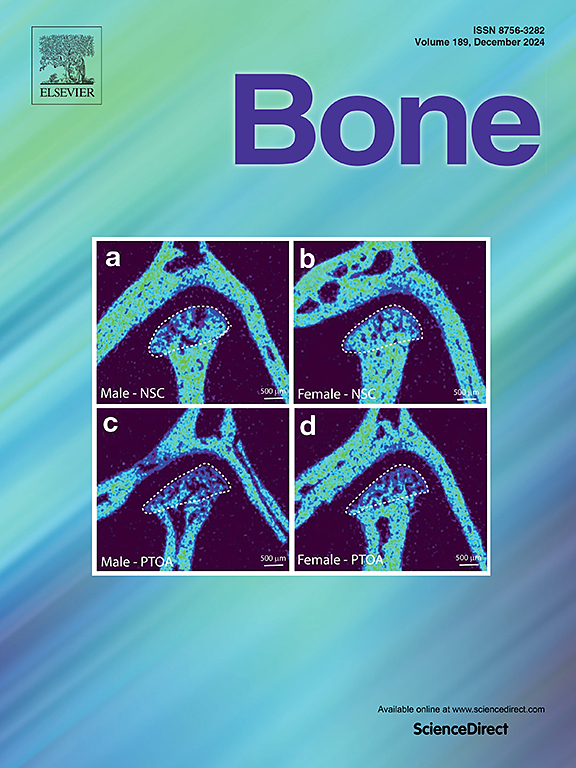Exercise-induced interactions between skeletal muscle and bone via myokines and osteokine in mice: Role of FNDC5/irisin, IGF-1, and osteocalcin
IF 3.6
2区 医学
Q2 ENDOCRINOLOGY & METABOLISM
引用次数: 0
Abstract
Skeletal muscle and bone interact to maintain their structure and function. Physical exercise is the most effective and easily applicable strategy to maintain their functions; however, exercise-induced interactions by soluble factors remained elusive. Our study aimed to identify exercise-induced interactions between muscle and bone by examining (1) the effects of myokine on bone and (2) the effects of osteocalcin (OCN) on skeletal muscle. To understand the effects of exercise-induced myokines on bone, we examined the effects of FNDC5 for aerobic exercise and IGF-1 for resistance exercise using a muscle-specific myokine overexpression model. To examine OCN effects on muscle, mice were intraperitoneally administered OCN-neutralizing antibody during long-term exercise. Our result showed that aerobic exercise tended to increase serum HA-tag protein attached to FNDC5 in muscle-specific overexpression groups. In addition, osteoblastic activation was increased only after aerobic exercise with HA/FNDC5 overexpression. Resistance exercise did not alter circulating HA-tag (muscle-derived IGF-1) and bone metabolism after IGF-1/HA overexpression. In the OCN study, aerobic exercise enhanced endurance capacity by restoring muscle glycogen content; however, OCN neutralization returned these to baseline. After resistance exercise, OCN suppression inhibited muscle hypertrophy and strength gains by preventing protein synthesis. Our results suggest that aerobic exercise following FNDC5 muscle overexpression promotes osteoblast activity, which may be partially caused by muscle-derived FNDC5 secretion. In addition, OCN was necessary for muscle adaptation in both aerobic and resistance exercises.
运动通过肌动蛋白和骨激肽诱导小鼠骨骼肌和骨骼之间的相互作用:FNDC5/鸢尾素、IGF-1 和骨钙素的作用
骨骼肌和骨骼相互作用,以维持其结构和功能。体育锻炼是维持肌肉和骨骼功能的最有效、最易操作的策略;然而,运动诱导的可溶性因子之间的相互作用仍然难以捉摸。我们的研究旨在通过研究(1)肌动蛋白对骨骼的影响和(2)骨钙素(OCN)对骨骼肌的影响,确定运动诱导的肌肉和骨骼之间的相互作用。为了了解运动诱导的肌动蛋白对骨骼的影响,我们利用肌肉特异性肌动蛋白过表达模型,研究了有氧运动中 FNDC5 和阻力运动中 IGF-1 的影响。为了研究 OCN 对肌肉的影响,我们在小鼠长期运动期间腹腔注射了 OCN 中和抗体。结果表明,在肌肉特异性过表达组中,有氧运动往往会增加血清中附着于 FNDC5 的 HA 标记蛋白。此外,只有在HA/FNDC5过表达的有氧运动后,成骨细胞活化才会增加。IGF-1/HA过表达后,阻力运动不会改变循环中的HA-tag(肌肉来源的IGF-1)和骨代谢。在 OCN 研究中,有氧运动通过恢复肌糖原含量提高了耐力能力;然而,OCN 中和后,肌糖原含量恢复到基线水平。阻力运动后,OCN抑制通过阻止蛋白质合成来抑制肌肉肥大和力量增加。我们的研究结果表明,肌肉过表达 FNDC5 后进行有氧运动可促进成骨细胞的活性,这可能部分是由肌肉衍生的 FNDC5 分泌引起的。此外,有氧运动和阻力运动中的肌肉适应都离不开 OCN。
本文章由计算机程序翻译,如有差异,请以英文原文为准。
求助全文
约1分钟内获得全文
求助全文
来源期刊

Bone
医学-内分泌学与代谢
CiteScore
8.90
自引率
4.90%
发文量
264
审稿时长
30 days
期刊介绍:
BONE is an interdisciplinary forum for the rapid publication of original articles and reviews on basic, translational, and clinical aspects of bone and mineral metabolism. The Journal also encourages submissions related to interactions of bone with other organ systems, including cartilage, endocrine, muscle, fat, neural, vascular, gastrointestinal, hematopoietic, and immune systems. Particular attention is placed on the application of experimental studies to clinical practice.
 求助内容:
求助内容: 应助结果提醒方式:
应助结果提醒方式:


